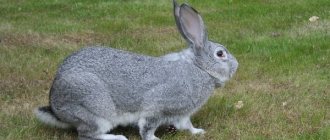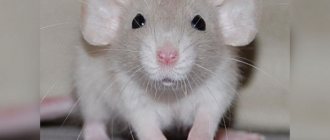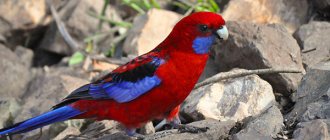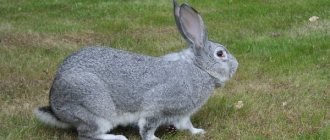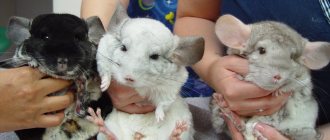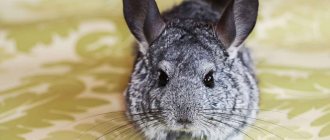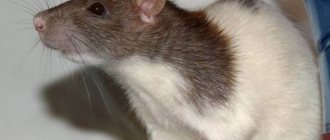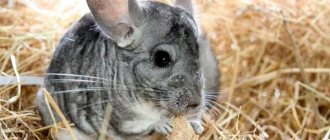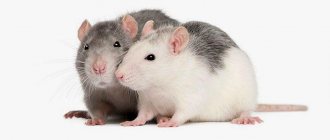Many members of the older generation became acquainted with the chinchilla cat thanks to the James Bond movie saga. The villain Ernst Stavro Blofeld had such a pet. And this was enough for all pet lovers to start talking about the unusual breed of cats. For some time it was believed that we were talking about an as yet unknown elite group. Only later did detailed data about the silver and golden chinchilla color appear.
How did chinchilla cats appear?
England is the homeland of fluffy beauties. It is believed that these cats were born back in 1882 as a result of an accidental crossing of an outbred domestic cat and a Persian cat.
Chinni, as the baby was named, received a non-standard smoky color from her parents, which interested the owner. Subsequently, the breeder crossed Chinny and a gray striped cat, but the result was unsatisfactory: there was no unusual haze in the color of the kittens’ fur.
A few years later, the descendants acquired the desired chinchilla color, and appeared at London exhibitions at the Crystal Palace in 1894. The apricot color appeared much later among American breeders.
For about 30 years, the breed was small in number, despite the efforts of breeders. The 30s of the 20th century changed the situation, and the population increased significantly, thanks to which the first breed standard appeared in 1952.
Registration
The British breed was first registered in 1980 by the CFA or Cat Fanciers' Association. Later, the British were recognized by a number of other international felinological organizations:
- WCF - World Cat Federation;
- FIFe - International Cat Federation;
- TICA - International Cat Association;
- IFA - International Felinological Association (Russia and CIS countries).
When trying to recognize Chinchillas as an independent line, breeders encountered difficulties. Their differences from British cats were only in color and coat, which is why not all organizations rushed to register the new breed. Officially, British Chinchillas are an intra-breed variety and felinologists, when registering nurseries, indicate the breed - British Shorthair.
Appearance of chinchillas
Outwardly, they are similar to their “relatives” of Persian cats, which are characterized by white fur with small dark patches, thanks to which a shimmer of silvery shine is visible. Emerald green eyes edged with black. The chinchilla was the first breed whose color was obtained through deliberate selective breeding. It was first presented in 1894 at the World Exhibition at the Crystal Palace in London.
There are several groups of characteristic colors for chinchillas. The first group includes dark shades: chocolate, cinnamon, silver tint. The second includes, based on the red tone: red and cream chinchilla cat. The third category includes tortoiseshell colors: silver and chocolate tortoiseshell. And in the last one - these are diluted tortoiseshells: lilac-cream, fawn and cream with a blue tint.
Genetics of color
A polygenic complex is responsible for the golden chinchilla color, providing a warm shade of the undercoat and a lightened background color:
- melanin inhibitor – absorbs hair pigment, starting from the hair root;
- agouti and tabby (tabby) - forms a pattern;
- erizer – gene eraser, gives the undercoat a warm shade.
The golden chinchilla color includes several varieties depending on the color of the hair tips:
- black;
- chocolate;
- lilac;
- faun (fawn);
- cinnamon (cinnamon);
- blue.
The golden color is a recessive trait in relation to the silver color. Kittens of this color can be obtained in the following cases:
- both manufacturers have a golden color;
- parents are silver chinchillas, but are carriers of the golden gene;
- one producer is golden, the second is silver, but his genotype contains genes for goldenness.
Breed standards
It identifies characteristics inherent in animals. The standard maintains the purity of the breed and is a document that allows participation in breeding and exhibitions.
It is used by breeders, judges and breeders. One might say that this is the “basic law” of felinology. In essence, this is a description of the breed in strict order. Standard for Chinchilla Persians:
- rounded and soft lines of a small head with a convex skull and a squat, compact body.
- Males in adulthood reach a weight of 7 kg, and females 3.5-4.5 kg.
- Widely spaced ears with rounded ends.
- Bright, wide-set, large eyes with black rims.
- Pale pink or brick red short nose.
- Short stocky paws with dark pads.
- Short straight tail.
Thick long hair. Kittens of this breed are born with short hair, but over time it becomes longer.
Interesting photo
British chinchilla in all its glory
Silver British Chinchilla
Initially, kittens are born with tabby color.
Golden British Chinchilla
British chinchilla color options
Character of chinchilla cats
They have a soft and friendly character. Thanks to their high intelligence, chinchilla cats get along well in an apartment; with proper training, they use a scratching post, so furniture and walls will not be damaged by sharp claws.
They carefully examine the home and every corner without causing problems to the owner. Representatives of this breed are a little phlegmatic, so pranks are not inherent in them.
Chinchillas are great companions for people who live alone because cats do not become overly sad when their owner is away.
Cats get along quite well with other animals and are friendly, but this breed is not among the best for contact with children, although each pet is individual. The best option is when both animals live together since childhood, then there will be no aggressive relationship between them. If different ages or genders are combined, conflicts may arise.
Interesting Facts
Chinchillas gained modern popularity thanks to the British Princess Victoria. Fascinated by the color of the cat, she spread the fashion for the breed among the nobility of the royal court.
The exhibition at the National History Museum in London includes a stuffed chinchilla cat. This representative of the breed was the owner of a record number of awards and titles at cat shows.
Chinchillas are rightfully considered one of the most beautiful and unusual cats. They are sociable, friendly, do not spoil things, and love their owner very much. But, before purchasing such a beauty, you need to soberly assess your capabilities. These aristocratic creatures deserve full care and maintenance.
Diseases inherent in chinchillas
Despite good health, during breeding and selection of certain traits, diseases at the genetic level were practically not established in the breed, this is due to the fact that breeders mixed different breeds of cats and less often resorted to inbreeding, i.e. breeding a breed by crossing close relatives to consolidate signs.
Due to the anatomical features of the skull, Persian chinchillas have increased tear production. To prevent possible eye problems, you need daily eye care. To do this, you need a napkin moistened with water. We take it and wipe the eyes and the area around them until the wool is clean. Then treat the area with grooming paste and comb it with a special brush, which can be bought at a pet store. The final stage is sprinkling with special powder.
Chinchillas are classified as Persians, and since they are a genus of long-haired cats. Accordingly, they have typical problems for owners of long hair.
When washing, the cat's rough tongue collects excess hair and swallows it. This is fraught with regurgitation of lumps and diseases of the digestive system and gastrointestinal tract. For this reason, they need regular combing of dead hairs.
Due to the small head and flat muzzle, the jaw may become deformed. Eating may be difficult if the food and water bowls are not suitable, for example, they are too small for the head to fit through. Due to the distortion of the airways, chinchillas may experience breathing problems.
At the genetic level, some cats have a gene that causes kidney failure. In the 1990s, a study found that more than 30% of shorthaired Persians had polycystic kidney disease, but it was less common in chinchilla cats.
About castration
A sensitive topic among cat lovers: sterilization should not be regretted. Each owner decides for himself, but what do experts think about this? Opponents rely on myths that it is “good for health” and has a beneficial effect on the animal’s psyche.
In fact, there is no concept of “sexual dissatisfaction” for a pet. If behavior changes for the worse, then the problem may be hormonal changes or hidden diseases. An examination by a veterinarian will answer this question.
For example, unsterilized cats that have not become pregnant may develop cystic degeneration of the ovaries and uterus, and mastopathy. Prostate lesions are common in cats. Veterinary clinics are unanimous: if the animal is not involved in breeding, castrate it.
About vaccinations
The mother cat transmits immune bodies through milk that support the protection of babies from diseases, so vaccinations are given no earlier than two months of age. Vaccination is carried out according to age according to the preventive calendar:
- Upon reaching 8 weeks, they are vaccinated against panleukopenia, rhinotracheitis, chlamydia, microsporia and calcivirosis.
- The next stage is 10-12 weeks. At this time, a repeat vaccine is administered, plus one against rabies.
- At 16 weeks - viral peritonitis, and again after 4 weeks.
- The final stage is revaccination every year.
The procedure can be carried out safely by a doctor only for healthy animals after a preliminary examination.
Education and training
Chinchillas need to be raised and trained using the same methods as all cats, but taking into account the individual characteristics of each breed. Mandatory skills and abilities that the animal must master by the age of one year:
- the ability to respond to one’s own nickname;
- go to the toilet and sharpen your claws in a strictly designated place;
- observe the sleeping and feeding schedule, do not wake the owner at night;
- sit calmly in the owner's arms;
- adequately perceive the need for transportation: traveling in a carrier bag, traveling by car.
Owners of show pets will also have to work on the technique of displaying the animal at an exhibition. Since both the British, the Persians, and the Scottish have a compact body, in the ring they are not exhibited “stretched” like Orientals, but in a grouped state. Preparation for this action is considered to be the development in the cat of the habit of sitting on the laps and hands of the owner, as well as patiently accepting changes in posture at the insistence of the person.
Persian chinchillas are intelligent and highly intelligent cats, grasping basic cat wisdom on the fly. For example, by 1-1.5 months, kittens go to the litter tray quite carefully. Often, if babies live with their mother or another adult cat, they don’t even need to be taught this skill - the furballs independently copy the behavior of the older pet.
Young and even slightly mature chinchillopers retain a lively interest and curiosity in things they see for the first time, so at first you will have to hide indoor plants, toxic detergents and cleaners, as well as the wires of household appliances from the animal. The breed does not produce any destructive actions - chinchillas do not scratch furniture (provided that there is a normal scratching post in the house), they do not rummage through the owner’s plates, and they do not take away piece by piece a newspaper forgotten by the bed.
At the beginning of socialization, it is important for a kitten in a new home to create a peaceful atmosphere, so try to make less noise in the presence of the baby and warn your household about this. Classes should be carried out taking into account the chinchilla’s biorhythms: in the mornings and afternoons, cats are inactive and prefer to take a nap. And of course, keep in mind that not a single pet is capable of multitasking, so if you decide to practice one command, finish what you started without switching to teaching your furry other useful skills.
Chinchillas from the British and Scottish clans are hampered in their studies by natural shyness and timidity. These comrades are generally frightened by everything new and unknown, so during lessons, talk more with your pet in an even, calm voice. A chinchilla doing dirty tricks is such a rare phenomenon that not every owner of the breed manages to see it. If, nevertheless, the pet is drawn to the “scratchers” or the dining table, influence the animal with its own fears. Suddenly clap your hands or secretly splash water on the furry criminal - then you can only watch how the chinchilla coward quickly runs away from the crime scene, turning into a quiet good boy.
How to choose a cat?
There are several rules that can protect you from unscrupulous scammers. It should be remembered that this breed is not common in the CIS, there are few qualified nurseries, so the average price tag is quite high.
For this reason, do not buy kittens from the market. An animal can only look like a chinchilla, but not be one. In addition, responsible breeders sell offspring through clubs and subsequently monitor their fate. This does not mean that the cat will be bad; while maintaining the demand for such kittens, sellers will continue to be interested in unscrupulous business.
Kittens are very curious, so a healthy pet will be interested in meeting the future owner. If he is shy, aggressive or looks lethargic, then this indicates poor living conditions.
If you want to know how a kitten will grow up, then look at its parents. If the mother cat is near the children, then the father can be seen in copies of his documents or photographs.
Differences in feeding
It is not the best option to take a one-month-old kitten away from its mother cat. However, if this happens, you will have to follow a lot of rules and recommendations in caring for him and in particular in feeding. Read about this in a separate, specialized article.
Then everything will be easier, since Chinchilla kittens are perfectly suited to the general rules of feeding kittens according to the appropriate age.
The pet's diet must be balanced. If the owner prefers to buy finished products, then the food should only be of high quality. Natural food includes meat, fish, vegetables and dairy products. British breed cats are fed 2-3 times a day. Periodically, the pet is given vitamin and mineral supplements.
In both cases, an automatic cat feeder will help you a lot, as it accurately measures the required amount of food, dispenses it on time, and notifies you about it on your smartphone.
In addition, it comes with an automatic drinking fountain. It provides your pet with clean, filtered water enriched with oxygen.
You should not implement the idea of mixed feeding. Chinchillas' digestive organs will not have time to “readjust” to the next diet, which can lead to overload on the gastrointestinal tract. The consequences will be serious diseases, deficiency of some vitamins and excess of others.
Warning! Chinchilla cats are prone to obesity and food allergies. Therefore, it is highly undesirable to offer them food of questionable quality. Chinchilla cats are prone to obesity and food allergies. Therefore, it is highly undesirable to offer them food of questionable quality.
How to care for a chinchilla cat?
Caring for pets begins even before they are born. Proper nutrition of the expectant mother is the key to healthy offspring. A balanced diet consists of raw meat products and offal, as well as fermented milk in small quantities. Vegetables and fruits are added to balance microelements. For proper intrauterine development of kittens, the mother does not set up a den in a quiet place.
Conditions of detention
A cat's long and fluffy fur requires daily care. You need to comb it at least once a day, but it is acceptable to do this once every 2 days. Otherwise, tangles cannot be avoided. First, the animal is combed according to the growth of its fur, then against it.
On the muzzle and cheeks, the hair is combed towards the muzzle, that is, against the hair growth. Do not worry that the animal will behave restlessly during these manipulations. Chinchillas love to be brushed. Even against the grain.
Like most felines, chinchillas are small fans of bathing. In addition, frequent bathing can cause their fur to turn yellow. This can be avoided by using a special whitening shampoo. You should bathe your cat no more than once every six months, and you should be prepared for inappropriate behavior of your pet.
It is important to ensure that water and shampoo foam do not get into your cat's eyes and ears.
After water procedures, you need to wrap it in a warm towel and let it dry a little like that. You can dry your pet's fur with a hairdryer, setting it to warm air. It is not advisable to comb wet fur.
When brushing and checking your cat's body every day, pay attention to the fur between the pads of your toes. It can also be combed and, if necessary, trimmed.
Otherwise, the hair in these places will bunch up, rubbing the delicate pads.
An alternative to water and wash is to use dry shampoo. It does not require rinsing with water, but is simply combed out of the wool. First, you need to comb the fur coat, and then rub dry granules into the fur. After a while, the fur is combed out again. Dry shampoo should be used every 14-17 days. This will make the animal's fur fluffy, shiny, and remove excess fat and dirt.
You don’t need any special care for your ears; it’s enough to clean them with a cotton swab once a week or less often, as they get dirty. Only the visible part of the ear is cleaned. Trying to penetrate deeper, especially with a cotton swab, is dangerous for the animal.
But the eyes of cats, like their fur, require constant care. The fact is that individuals of this breed are prone to increased lacrimation, so the eyes need to be wiped every day with a soft damp cloth or a damp cotton pad.
While still a kitten, you should accustom your chinchilla to a scratching post, and trim the claws with special tools once a week. You only need to cut off a third of the claw, but if you cut most of it, the blood vessels passing through this part of the claw will be damaged.
As for walks, they are pleasant for the animal, but not necessary. If you live in a private house, you can let the cat out for a walk in the garden. Naturally, making sure that there is no danger for him there, and also putting an anti-parasitic collar on him. In the city, it is better to walk your pet on a harness.
It is important to keep the tray clean by regularly changing its contents. You can use any filler that is convenient for you.
If you follow these simple rules, then there will be no unpleasant odor in the house, and the animal will not shit outside its toilet.
From the first days of life
Complementary feeding and litter box training begin when kittens reach 4-5 weeks of age. When raising one, it should be taken into account that a cat is not a person; it is not characterized by associative thinking and understanding of human behavior. If you set a ban for her, then it is forever.
Toilet training is taught from the first steps, for this:
- fence off the space for 2-3 weeks;
- put two small trays;
- fill with filler with small granules.
This is necessary so that the kitten remembers its smell and subsequently goes to only one place. If the baby has done “big” things bypassed, then put it in the litter with a scoop and do not remove it.
Long-lived domestic cats
The record holder for life expectancy is a cat named Lucy, who lives in the UK. According to official data, she is 43 years old. Translating to our human age, it turns out that the cat is almost 175 years old. In second place is the cute cat Cream Puff, originally from the USA, who lived a happy life at the age of 38, leaving this world in 2005.
Well, in third place among long-livers among mustachioed fluffy pets is a cat who once lived in Devon (England). He lived happily until his 36th birthday, after which he calmly passed away. By the way, the mentioned animals are Guinness Book record holders in the section of long-livers among domestic cats.
Adult pets
For pet chinchillas that do not participate in exhibitions, care will not be difficult. The owner of the “Show Dream” nursery in an interview shared advice on caring for a cat’s fur: once a month, using specialized shampoos, you need to bathe an adult cat, and kittens twice, and after the bath, dry it with a hairdryer to completely remove fallen hairs. She also explained that it is advisable to comb the cat once every 1.5-2 weeks to prevent the formation of tangles.
Nutrition can be provided in two ways: make a diet from fresh food or buy premium or super-premium food, for example, Brit, Brit care. When it comes to dry food, holistic foods, such as Acana, are considered the best. There are separate lines for pets with urolithiasis.
If one food suits the animal, the stool is in good condition, the eyes are shiny and the coat is in good condition, then there is no need to mix different tastes, it is enough to feed one type.
Vaccinations
Good health is an integral part of a long and happy pet's life. To maintain it, the animal must be vaccinated.
Vaccination begins at an early age. The first vaccinations are given at the age of one and a half to two months. Injections are given against rabies, rhinotracheitis, feline distemper and calcivirosis. Then, after two and a half to three months, revaccination occurs. Then vaccinations are given annually, once a year. The selection of a quality drug should be entrusted to a veterinarian.
Ten days before vaccination, the animal must be dewormed.
Origin story
The origins of the chinchilla breed begin with a cat named Chinnie. The kitten had a darker color than modern representatives of this breed. It took the ingenuity of the breeders of that time to give her coat the current light iridescent color.
To obtain a new unique breed, Sheenie was crossed with a purebred classic British. Further, during the crossing process, a problem arose with the fact that it was not possible to obtain the required eye color. In descendants it acquired a yellow-green tint.
The silver tabby with which this breed was later bred gave the eyes some blurriness. A blue shorthaired breed also participated in this process. The final stage was the addition of Persian blood. The classic chinchilla color in cats originated from a representative named Beauty.
Predisposition to diseases
The British Shorthair has a long history, and one of the results of meticulous selection is that these animals have excellent health and excellent disposition. This is a long-lived breed. However, due to crossbreeding with Persian cats, some members of the chinchilla variety sometimes have kidney disease, although this is not common.
Polycystic kidney disease and blood type B
In the 20th century, British Shorthair breeders used Persian cats to create a chinchilla line.
Persians are prone to an inherited kidney disease called polycystic kidney disease. Since then, outbreaks of this disease have been periodically reported in the UK. A more common problem for British cats is the rare blood type that some of these cats have. British Shorthairs can be Type A or Type B. Most have Type A blood. Some have Type B. It is not a blood disorder, and Type B cats are just as healthy as Type A cats. But for breeding purposes or if blood transfusions are needed this must be taken into account. Type A blood will kill a cat with type B blood and vice versa. British shorthair breeders are worried about blood type due to "fading kitten" syndrome. When the mother cat has type B blood and the father of the kittens has type A blood, their kittens can have both type A and type B blood. Mother's milk contains antibodies to type A, which will kill type A kittens within 72 hours. Fortunately, there is now a DNA test to check the blood type before breeding a cat.
Buying a kitten
When buying a British chinchilla, you need to pay attention to the cat's parents. If the color of their coat does not meet the standard, then, most likely, the kittens from them will have an even more non-standard color.
You should definitely ask the breeder if the kitten’s parents have hereditary or chronic diseases.
The cost of such a miracle will depend on the conditions of detention, the presence of a pedigree and the purpose for which the kitten is purchased. In a nursery you can find such a kitten for 2,000 rubles, and if you need a show kitten with an excellent pedigree and the best nutrition, then the price for it will be approximately 25,000 rubles.
Breeding
Breeding chinchillas in Russia is accompanied by certain difficulties. Due to the difficulty of caring for and maintaining the color, there are few specialized breeders.
British silver or golden chinchillas can mate, but finding a partner for this animal is quite difficult.
If a partner is found, prepare the cat (or cats) for mating. Check with your veterinarian to make sure both animals are healthy. Carry out deworming. These measures will minimize the risk of having sick or abnormal offspring.
Scottish
The Scottish chinchilla cat has the same color as the British one. She has a plush coat, a dense undercoat of a warm shade, dark lining of the eyelids, lips and nose, and brown paw pads.
The eyes are most often green, but can also be blue. These animals have soft, rounded body shapes, which provide developed muscles and thick hair.
Purebred kitten - choose the right one
Buying a chinchilla kitten is difficult, if not very problematic.
The main difficulty is that the magnificent color of the animal is pathologically unstable.
And the golden cat, and the smoky British, and the ordinary Persian cannot guarantee the appearance of the ideal color of chinchillas.
Look at the baby's parents, make sure that they are white cats in color and have no deviations from the norm.
Decide which chinchilla, British or Persian, to buy based on the psychological portrait of the animal and your own breed preferences.
You should approach the purchase of a golden chinchilla baby responsibly. The price for a show class furry can reach up to $1000. Therefore, choose trusted breeders.
Be sure to talk to the breeder about vaccinations, diet and general health of the baby. Check that you have all the documents and get ready to make your new family member happy.
Persian
Persian chinchillas are slightly smaller than their counterparts. They are harmoniously built, distinguished by fine bones and elegance, but at the same time strong and resilient. In the USA, larger cats are bred, which are very similar in size and build to standard Persians.
The coat of Persian golden chinchillas is long and dense. The fur shimmers beautifully in the light. The cat may have emerald or bluish eyes with a brown rim. The soft pink nose is small and neat.
